Ohio, known as the “Buckeye State” or the “Heart of It All,” is a state in the Midwestern region of the United States. It’s famous for being the cradle of aviation, the birthplace of many celebrities, and American football. Before all these, during the Cambrian period, Ohio was home to prehistoric animals. The sea covered the state throughout the early Paleozoic and was home to bony fishes, sharks, graptolites, trilobites, and corals.
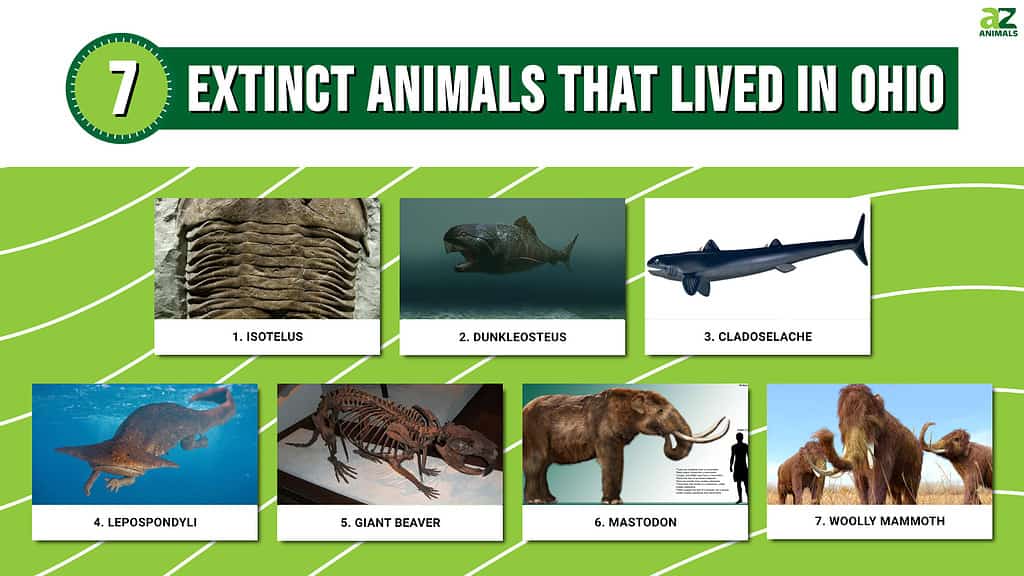
During the Ice Age, Ohio provided a habitat for mastodons, mammoths, and giant beavers. Read on for more information on the extinct animals that lived in Ohio.
7 Extinct Animals That Lived In Ohio
Numerous fossils have been discovered throughout Ohio, many of which are incredibly preserved. Virtually none of these fossils were laid down during the Precambrian, meaning that no dinosaurs have ever been discovered throughout the state. But still, many megafauna mammals called Ohio home during the Cambrian Period and the last Ice Age.
Here are 7 notable extinct animals that lived in the Buckeye State.
1. Isotelus

Isotelus is a genus of trilobites from the middle and upper Ordovician periods.
©iStock.com/markchentx
| Isotelus | |
|---|---|
| Kingdom | Animalia |
| Phylum | Arthropoda |
| Class | Trilobita |
| Order | Asaphida |
| Family | Asaphidae |
| Genus | Isotelus |
| Living period | Ordovician Period (about 488 million to 444 million years ago). |
Isotelus is the official state fossil of Ohio. Its remains were found in the southwestern part of the state. However, the largest complete specimen was excavated outside the Buckeye State. Isotelus rex, a two-foot fossil from Canada, remains the world’s largest trilobite ever discovered.
Isotelus is a genus of trilobites from the middle and upper Ordovician periods. It was among the largest marine-dwelling, bottom-feeding invertebrates, similar in appearance to lobsters and crabs. It’s thought that this species became extinct due to the rapid onset of global climatic cooling and loss of tropical shelf habitats caused by the terminal Ordovician extinction event that occurred millions of years ago.
2. Dunkleosteus
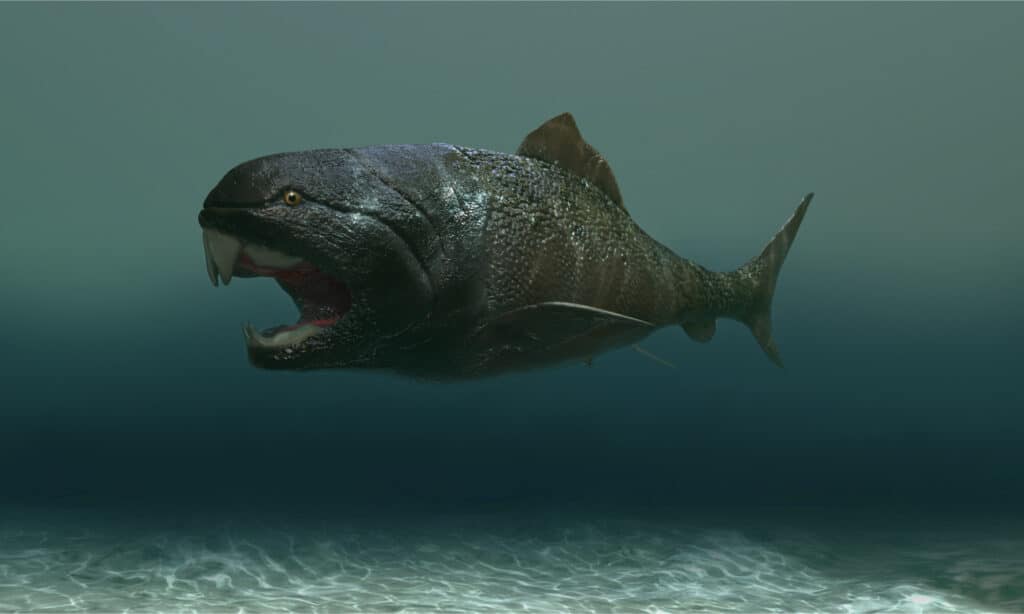
Dunkleosteus was an extinct member of the jawed fish that lived during the Late Devonian period.
©Esteban De Armas/Shutterstock.com
| Dunkleosteus | |
|---|---|
| Kingdom | Animalia |
| Phylum | Chordata |
| Class | Placodermi |
| Order | Arthrodira |
| Suborder | Brachythoraci |
| Clade | Eubrachythoraci |
| Clade | Pachyosteomorphi |
| Superfamily | Dunkleosteoidea |
| Family | Dunkleosteidae |
| Genus | Dunkleosteus |
| Living period | The Late Devonian period, about 382 million to 358 million years ago |
Dunkleosteus was an extinct member of the jawed fish that lived during the Late Devonian period, about 382 million to 358 million years ago. It was one of the largest prehistoric fish to have ever lived. The massive species was estimated to have grown up to 29 feet in length from head to tail and weighed approximately 8,800 pounds (4.4 tons).
Along with most placoderms, Dunkleosteus was covered with armored plating. It also had two major pairs of sharp bony plates, forming a beak-like structure. As seen in some modern sharks, this species was among the first vertebrates to internalize egg fertilization.
This creature has been widely depicted in various media and games, such as the Animal Planet series River Monsters episode “Prehistoric Terror” and the 2003 BBC TV series Sea Monsters: A Walking with Dinosaurs Trilogy, among many other depictions. Dunkleosteus fossils discovered in Ohio are incomplete. The most famous and nearly complete specimens are displayed at the American Museum of Natural History and other places in Pennsylvania and Brisbane.
3. Cladoselache

Cladoselache is considered a fast-moving marine predator due to its deeply forked tail and streamlined body.
©Catmando/Shutterstock.com
| Cladoselache | |
|---|---|
| Kingdom | Animalia |
| Phylum | Chordata |
| Class | Chondrichthyes |
| Order | Symmoriiformes |
| Family | Cladoselachidae |
| Genus | Cladoselache |
| Living period | About 385–359 million years ago |
Cladoselache is the most famous prehistoric shark discovered in the Cleveland Shale Formation. It’s an extinct shark-like species that dates back to the Late Devonian. Based on fossil analysis, Cladoselache is considered a fast-moving marine predator due to its deeply forked tail and streamlined body. Its skull consisted of central cranial cartilage, which protected the brain and other sensory organs. The longest Cladoselache specimen measured 6.6 feet.
4. Lepospondyli
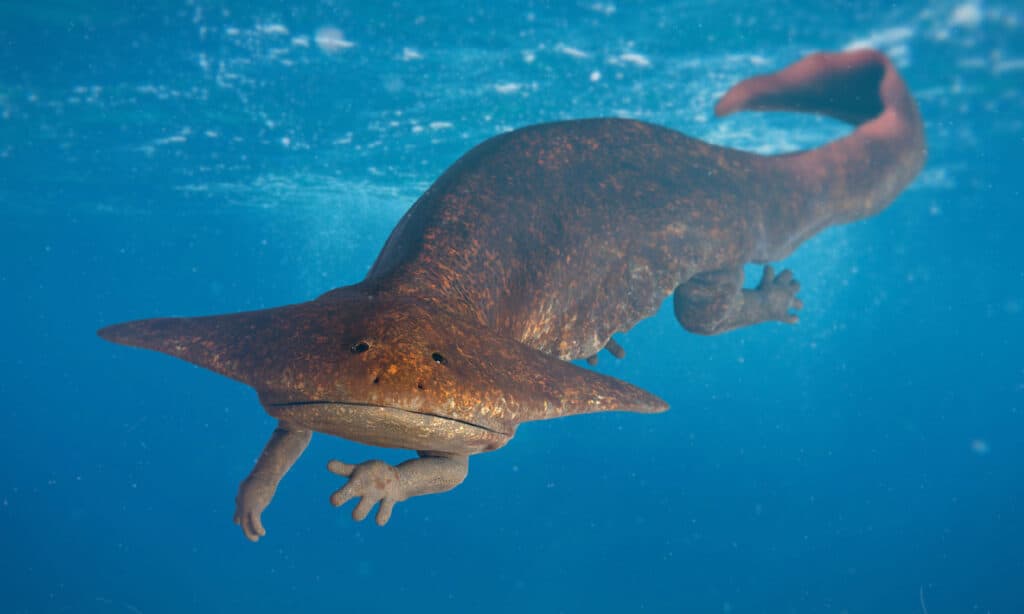
Lepospondyli is a diverse species of tetrapod that lived from the Early Carbonifemajorhe to the Early Permian.
©iStock.com/dottedhippo
| Lepospondyli | |
|---|---|
| Kingdom | Animalia |
| Phylum | Chordata |
| Clade | Reptiliomorpha |
| Subclass | Lepospondyli |
| Living period | About 345 million to 265 million years ago |
Lepospondyli is a diverse species of tetrapod that lived from the Early Carbonifemajorhe to the Early Permian. They all went extinct, except one late-surviving species from the Late Permian of Morocco called Diplocaulus minumus. Lepospondyls came in a diverse range of body forms. Some were lizard-like, while others had snake-like or newt-like body forms. All species were characterized by spool-shaped vertebrae that grew as bony cylinders around the notochord. Most species didn’t reach a meter in total length.
5. Giant Beaver

The giant beaver fossils were discovered in a peat bog in Ohio in 1837.
©Steven G. Johnson / CC BY-SA 3.0 – License
| Giant Beaver | |
|---|---|
| Kingdom | Animalia |
| Phylum | Chordata |
| Class | Mammalia |
| Order | Rodentia |
| Family | Castoridae |
| Subfamily | Castoroidinae |
| Genus | Castoroides |
| Living period | Between 1.4 million and 10,000 years ago |
The giant beaver, also known as Castoroides, is an extinct genus of massive beavers that inhabited North America during the Pleistocene. The giant beaver was much larger than modern beavers, with an average length of between 6.2 and 7.2 feet. Its weight varied from 198 to 276 pounds. Its teeth were also much larger than modern beavers’ and had a striated, textured enamel surface. Modern beavers have smooth enamel surfaces.
The giant beaver fossils were discovered in a peat bog in Ohio in 1837. More specimens were later recorded from Alaska and Canada to Florida. Based on fossil analysis, this creature is thought to have gone extinct during the Pleistocene-Holocene Transition 12,800–11,500 years ago, alongside other megafauna mammals like steppe bison, mammoths, and mastodons.
6. Mastodon
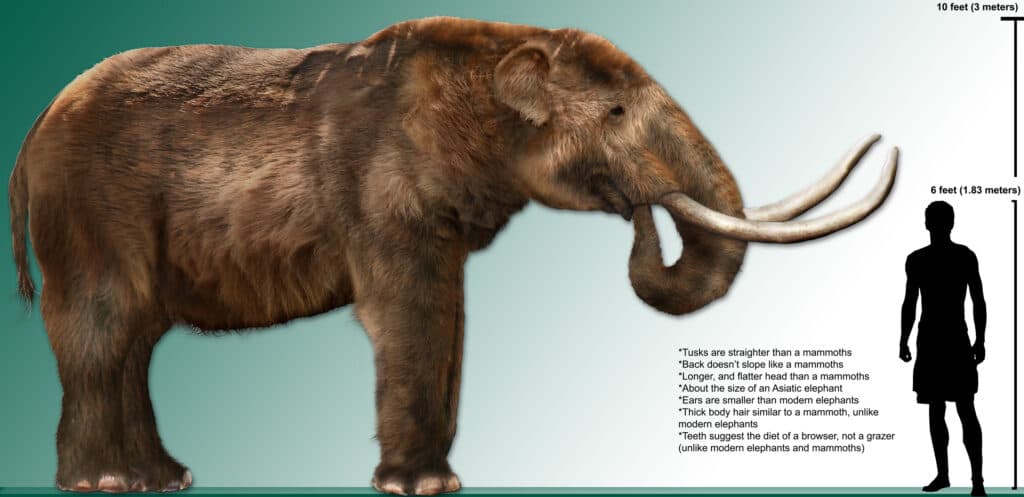
Mastodons also had longer bodies and shorter legs and were more muscular than mammoths.
©CC BY 3.0 / Dantheman9758 – License
| Mastodon | |
|---|---|
| Kingdom | Animalia |
| Phylum | Chordata |
| Class | Mammalia |
| Order | Proboscidea |
| Family | Mammutidae |
| Genus | Mammut |
| Living period | Late Miocene or late Pliocene – 11,000 years ago |
A mastodon is an extinct genus of mammut that lived in North and Central America during the Late Miocene or Late Pliocene until its extinction at the end of the Pleistocene. Modern reconstructions based on partially discovered fossils reveal that mastodons closely resembled modern-day elephants in appearance more than mammoths.
Compared to mammoths, mastodons had shorter, straighter tusks, up to 8 feet long. Mastodons also had longer bodies and shorter legs and were more muscular than mammoths. They weighed 8.6 to 12 tons and were about 7 feet tall at the shoulders.
Complete mastodon bones and tusks have been excavated in Ohio. Fossil analysis suggests that climate change and human hunting were the key factors that led to the mastodon extinction.
7. Woolly Mammoth
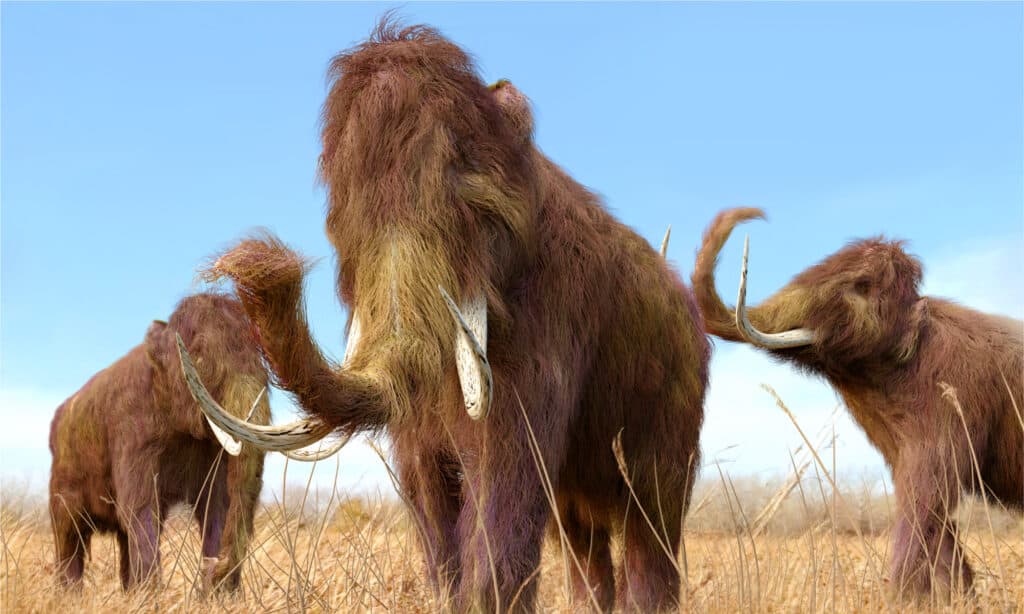
The woolly mammoth is well-known for its long-curved tusks and a layer of fur covering all body parts.
©Aunt Spray/Shutterstock.com
| Woolly Mammoth | |
|---|---|
| Kingdom | Animalia |
| Phylum | Chordata |
| Class | Mammalia |
| Order | Proboscidea |
| Family | Elephantidae |
| Genus | Mammuthus |
| Species | Mammuthus primigenius |
| Living period | Between 800,000 years ago and 4,000 years ago |
The woolly mammoth lived the same time as the early humans. This incredible creature is well-known for its long-curved tusks and a layer of fur covering all body parts. A fully grown male woolly mammoth weighed 12,000 pounds, while females weighed about 8,000 pounds. Males measured approximately 9 to 11 feet high at the shoulder, while females stood between 8.5 and 9.5 feet tall at the shoulder.
In addition to their fur, woolly mammoths had fat storage in their necks and withers to enhance food availability during winter. Their ears were smaller to reduce heat loss and frostbite. Their tails were also more petite for the same reason.
Summary Of The 7 Extinct Animals That Lived In Ohio
| Rank | Animal | Living Period |
|---|---|---|
| 1 | Isotelus | about 488 million to 444 million years ago |
| 2 | Dunkleosteus | about 382 million to 358 million years ago |
| 3 | Cladoselache | About 385–359 million years ago |
| 4 | Lepospondyli | About 345 million to 265 million years ago |
| 5 | Giant Beaver | Between 1.4 million and 10,000 years ago |
| 6 | Mastodon | 11,000 years ago |
| 7 | Woolly Mammoth | Between 800,000 years ago and 4,000 years ago |
The photo featured at the top of this post is © Esteban De Armas/Shutterstock.com
Thank you for reading! Have some feedback for us? Contact the AZ Animals editorial team.






